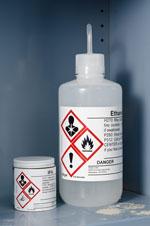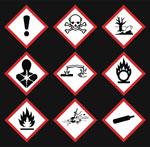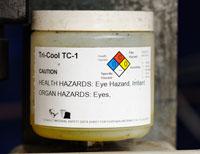Product Marketing Specialist
- FMA
- The Fabricator
- FABTECH
- Canadian Metalworking
Categories
- Additive Manufacturing
- Aluminum Welding
- Arc Welding
- Assembly and Joining
- Automation and Robotics
- Bending and Forming
- Consumables
- Cutting and Weld Prep
- Electric Vehicles
- En Español
- Finishing
- Hydroforming
- Laser Cutting
- Laser Welding
- Machining
- Manufacturing Software
- Materials Handling
- Metals/Materials
- Oxyfuel Cutting
- Plasma Cutting
- Power Tools
- Punching and Other Holemaking
- Roll Forming
- Safety
- Sawing
- Shearing
- Shop Management
- Testing and Measuring
- Tube and Pipe Fabrication
- Tube and Pipe Production
- Waterjet Cutting
Industry Directory
Webcasts
Podcasts
FAB 40
Advertise
Subscribe
Account Login
Search
Keeping up with hazardous communications regulations
New requirements bring changes in paperwork, labels, employee training
- By Danielle Gallo
- April 24, 2013
- Article
- Safety

Figure 1: OSHA updated its 29 CFR 1910.1200 on May 25, 2011, so that it aligns with the United Nations’ Globally Harmonized System (GHS) of Classification and Labeling of Chemicals. The goal is for all labels on potentially hazardous chemicals to look the same no matter where a manufacturing facility is located in the world.
Hazard communication is one of the most important occupational safety standards, as it ensures employees are made aware of the potentially hazardous chemicals and risks to which they may be exposed. With the extreme importance placed on hazard communication, it’s critical that employees understand the changes associated with the Occupational Safety and Health Administration’s (OSHA’s) alignment with the United Nations’ Globally Harmonized System (GHS) of Classification and Labeling of Chemicals.
History of Hazard Communication and the GHS
OSHA’s Hazard Communication Regulation (1910.1200) initially was developed in 1983 to inform employees of the hazardous chemicals they were working around. The regulation mandated that chemical hazard labels be applied to all chemical containers. In addition, material safety data sheets (MSDSs) needed to be supplied for each chemical and be accessible to employees. Workers also needed to be trained on how to identify hazards and how to work around the chemicals.
Almost every country in the world has guidelines or regulations with objectives similar to OSHA’s Hazard Communication Regulation: to warn employees or anyone coming into contact with the chemical about the hazards present. However, every country had different ways of categorizing, classifying, and depicting the hazards. With such varying guidelines and multiple language barriers across borders, selling and shipping chemicals globally became dangerous.
In 2002 the United Nations formally adopted the GHS to harmonize the hazard classification and labeling systems worldwide. This standardization included a way to classify hazardous substances and mixtures, pictograms and phrases for communicating hazard information, and a streamlined format for MSDSs and chemical labels.
Many countries and governments also have started incorporating elements of GHS into their standards, and OSHA has followed suit. OSHA’s 29 CFR 1910.1200 was updated on May 25, 2011, to align its elements with GHS.
Big Changes for Better Compliance
The Hazard Communication Regulation changed in many ways, but a few key changes have greatly affected the way facilities manage their labeling processes.
Revised Criteria for Classification of Chemical Hazards. About 880,000 different hazardous chemicals are used in the U.S. Each one must be reclassified by the chemical manufacturer per the GHS standard. This reclassification helps with the United Nations’ goal of streamlining chemical hazards globally.
Specified Format for Safety Data Sheets. The MSDS is now referred to as a safety data sheet (SDS) and has a new format. The new SDS has 16 specified sections to help streamline the information provided and make it faster and easier for employees to find the information they need.
Since every chemical is being reclassified, each will have a new SDS supplied by the chemical manufacturer. These will be filed and available for employee use.
Revised and Standardized Labeling Requirements. Each primary container’s chemical label must appear in the GHS format (see Figure 1). This new format will include the chemical name and manufacturer, as well as four new elements: a signal word, hazard pictograms (see Figure 2), hazardous statements, and precautionary statements.

Figure 2: These GHS pictograms are designed to be universal in meaning. From left to right starting at the top, the pictograms represent irritants, severe toxicity, environmental toxicity, aspiration toxicity, corrosives, oxidizers, flammables, explosives, and gases under pressure.
Secondary containers still need to be labeled per the employer’s hazard communication plan, with the label identifying the hazardous chemical and its appropriate hazard warnings (words, pictures, symbols, or a combination). Secondary container labels need to provide employees with specific information regarding physical and health hazards. This information cannot conflict with the GHS classification or information.
Many employers choose to use National Fire Protection Association (NFPA) 704 or hazardous materials identification system (HMIS) standards (see Figure 3) to label their secondary chemical containers. A variety of different solvents and degreasers used in day-to-day operations currently have those formatted labels. OSHA does not have a requirement for a specific label format on secondary containers, but it does mandate that the information provided cannot conflict with GHS classifications or hazard warnings.
Many metal fabrication and welding companies are electing either to label their secondary containers with a GHS-formatted label to be consistent with their primary containers, or to use a dual-label approach, placing the new GHS label alongside the previously used label. This second approach is preferred by many companies because it offers employees the comfort of a familiar hazard label while including the new information they need.
Employee Training Requirements for Labels and SDS. With the significant changes taking place, employee training is crucial. The initial training requirements for employees must cover the changes to the chemical label and SDS formats; new headings and the sequence of the SDS information; and the standardized label elements, which include pictograms, signal words, and hazard and precautionary statements.
The two most prominent differences that will affect worksites will be the significant changes to the GHS chemical label and SDS formats. Even common workplace chemicals such as benzene, toluene, and xylene will have different information displayed on their chemical labels and SDSs than what employees are accustomed to seeing. Employees must be given adequate training to fully understand how to read and interpret the new standardized formats.
OSHA’s requirement for annual training on hazard communication has not changed. As hazard communication continues to be one of the top-cited OSHA regulations, it is essential to ensure staff and facilities are updated on regulation changes and their effects on the workplace. Outside consulting or training companies can assist with preparing a facility for the changes.
Timeline of Critical Compliance Dates
OSHA has provided deadlines for mandatory implementation of the significant changes made to the 29 CFR 1910.1200 regulation:
- Dec. 1, 2013—By this date, every U.S. employee covered under the regulation needs to be trained initially on the regulation changes. This training should specifically cover the overview of the changes to the regulation, the SDSs, and the hazard chemical label (focusing on understanding the pictograms, signal word, hazard statements, and precautionary statements). This training is supplemental to a company’s annual hazard communication training.
- June 1, 2015—All chemical manufacturers need to have reclassified their chemicals, updated the chemical label formats to the GHS format, and updated the chemicals’ SDSs by this date.
- December 2015—By this date, all chemical distributors need to ensure that any product they are distributing has all of the updated information.
- June 1, 2016—This is the final day for full compliance. By this date, all employers need to make sure that their worksites have updated their hazard communication plan; updated all SDSs; archived previous MSDSs; and updated the workplace chemical labeling system, including secondary containers. This includes updating chemical labels for products in the workplace, such as in shipping/receiving areas, chemical storage areas, and workcells.

Figure 3: The National Fire Protection Association hazardous materials identification system standards use a color-coded array of four numbers or letters arranged in a diamond shape. An example is shown on the container. Hazard diamonds like this can be seen on trucks, storage tanks, and bottles of chemicals. The blue, red, and yellow fields (health, flammability, and reactivity) all use a numbering scale from zero to 4. A value of zero means that the material poses essentially no hazard; a rating of 4 indicates extreme danger. The fourth value, typically located in the white area, tends to contain a variety of letters or numbers, depending on the facility.
About the Author
Danielle Gallo
6555 W. Good Hope Road
Milwaukee, WI 53223
888-250-3082
subscribe now

The Fabricator is North America's leading magazine for the metal forming and fabricating industry. The magazine delivers the news, technical articles, and case histories that enable fabricators to do their jobs more efficiently. The Fabricator has served the industry since 1970.
start your free subscription- Stay connected from anywhere

Easily access valuable industry resources now with full access to the digital edition of The Fabricator.

Easily access valuable industry resources now with full access to the digital edition of The Welder.

Easily access valuable industry resources now with full access to the digital edition of The Tube and Pipe Journal.
- Podcasting
- Podcast:
- The Fabricator Podcast
- Published:
- 04/16/2024
- Running Time:
- 63:29
In this episode of The Fabricator Podcast, Caleb Chamberlain, co-founder and CEO of OSH Cut, discusses his company’s...
- Trending Articles
How to set a press brake backgauge manually

Capturing, recording equipment inspection data for FMEA

Tips for creating sheet metal tubes with perforations

Are two heads better than one in fiber laser cutting?

Hypertherm Associates implements Rapyuta Robotics AMRs in warehouse

- Industry Events
16th Annual Safety Conference
- April 30 - May 1, 2024
- Elgin,
Pipe and Tube Conference
- May 21 - 22, 2024
- Omaha, NE
World-Class Roll Forming Workshop
- June 5 - 6, 2024
- Louisville, KY
Advanced Laser Application Workshop
- June 25 - 27, 2024
- Novi, MI


























